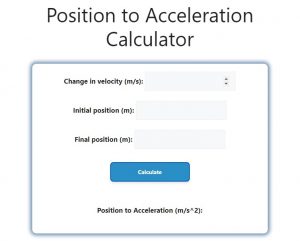About Position to Acceleration Calculator (Formula)
The Position to Acceleration Calculator is a tool designed to help you calculate the acceleration of an object by knowing its change in velocity and the difference in its position. Acceleration is a key concept in physics that describes how the velocity of an object changes over time, often due to applied forces. This calculator is useful in a variety of fields, such as mechanics, engineering, and motion analysis.
Formula
The formula for calculating acceleration using position and velocity is:
A = dV² / (2 * (p2 – p1))
Where:
- A = Acceleration
- dV = Change in velocity (final velocity – initial velocity)
- p2 = Final position
- p1 = Initial position
This formula calculates acceleration based on the square of the velocity change divided by twice the change in position.
How to Use
- Determine the change in velocity: Calculate the difference between the final and initial velocities (dV).
- Measure the positions: Identify the initial and final positions (p1 and p2).
- Input the values: Enter the values of dV, p1, and p2 into the calculator.
- Click Calculate: The result will show the acceleration based on the inputted data.
Example
Suppose an object moves from an initial position of 10 meters (p1) to a final position of 30 meters (p2), and its velocity changes from 2 m/s to 6 m/s. The change in velocity is:
dV = 6 – 2 = 4 m/s
Now, using the formula:
A = (4)² / (2 * (30 – 10)) = 16 / 40 = 0.4 m/s²
The acceleration is 0.4 m/s².

FAQs
- What is acceleration?
Acceleration is the rate of change of velocity of an object with respect to time. - Why do we use position to calculate acceleration?
Position, along with velocity changes, can help us determine the acceleration, especially in motion analysis scenarios. - What is the difference between velocity and acceleration?
Velocity is the speed of an object in a given direction, while acceleration measures how quickly the velocity changes. - Can acceleration be negative?
Yes, negative acceleration is known as deceleration and occurs when an object slows down. - What units are used in this calculation?
Typically, acceleration is measured in meters per second squared (m/s²), but other units like feet per second squared may also be used. - Can this calculator be used for free-fall calculations?
Yes, the calculator can be used for free-fall or other uniform acceleration scenarios, as long as velocity and position data are available. - Is the formula applicable for non-linear motion?
The formula assumes linear motion and may not be accurate for curved or rotational movement. - What happens if p2 is smaller than p1?
If the final position is less than the initial position, the object is moving in the opposite direction, and the result could be negative acceleration. - What is dV in this formula?
dV is the change in velocity, calculated as final velocity minus initial velocity. - Can I use this formula for constant velocity?
No, acceleration occurs when there is a change in velocity. If velocity is constant, acceleration is zero. - How does this formula relate to Newton’s second law?
Newton’s second law states that force equals mass times acceleration (F = ma), and this formula helps calculate acceleration, which can be plugged into Newton’s law. - What if the distance is unknown?
The formula requires known positions (p1 and p2) to calculate the acceleration. Without these, the calculation cannot proceed. - Can I use this formula for rotational motion?
No, this formula is specific to linear motion. Rotational motion would require angular velocity and angular displacement for calculation. - How does velocity impact acceleration?
A greater change in velocity over a shorter distance will result in higher acceleration, while a smaller velocity change over a longer distance results in lower acceleration. - Does the direction of movement matter in this formula?
Yes, since velocity and position are vector quantities, the direction of movement affects the acceleration’s sign (positive or negative). - What if there is no change in velocity?
If there is no change in velocity, then acceleration is zero, meaning the object is moving at a constant speed. - Can this calculator be used for real-world physics experiments?
Yes, it’s applicable for experiments where velocity and positional data can be accurately measured. - How does this formula apply to uniformly accelerated motion?
This formula is ideal for uniformly accelerated motion, where the velocity change happens consistently over a set distance. - Can I calculate time using this formula?
No, this formula only calculates acceleration based on position and velocity. To calculate time, you would need to use a different formula involving time. - What if I only know the final velocity?
You need both the initial and final velocities, as well as the positions, to use this formula accurately.
Conclusion
The Position to Acceleration Calculator is a useful tool for determining acceleration based on changes in velocity and position. By understanding how an object’s position and velocity change, you can easily calculate its acceleration, helping you analyze motion in various scientific and engineering contexts. Whether you’re studying mechanics or performing real-world experiments, this calculator simplifies the process of finding acceleration.